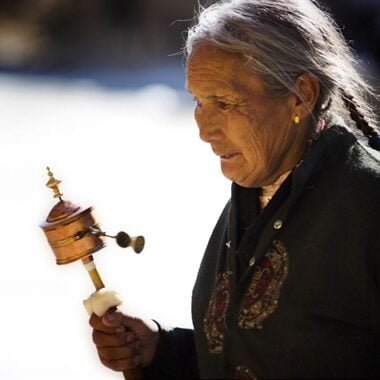Sacred Steps: How to Respect Tibetan Culture During a Mountain Pilgrimage (Kora)
For centuries, pilgrims have walked the kora—a sacred circumambulation route—around Tibet’s holy mountains like Mount Kailash and Nyenchen Tanglha. These journeys are…
For centuries, pilgrims have walked the kora—a sacred circumambulation route—around Tibet’s holy mountains like Mount Kailash and Nyenchen Tanglha. These journeys are deeply spiritual acts in Tibetan Buddhism, blending physical endurance with reverence. As a visitor, participating in a kora is a privilege, but it requires understanding local customs to avoid unintended disrespect. Here’s your guide to navigating Tibetan cultural norms on these sacred trails.
Core Cultural Customs to Follow
1. Walk Clockwise (Always)
- Why it matters: In Tibetan Buddhism, clockwise movement symbolizes alignment with the universe’s natural order.
- What to do:
- Follow pilgrims’ direction—never go counterclockwise, even for photos.
- At mani stone piles (rocks carved with prayers), pass them on your left.
2. Respect Religious Objects
- Taboos to avoid:
- Never step on or touch prayer flags, mani stones, or stupas (shrines).
- Don’t point feet at altars or statues.
- Respectful alternatives:
- Gently touch prayer flags with your head (a sign of blessing).
- Add a stone to a mani pile mindfully, reciting “Om Mani Padme Hum.”
3. Dress Modestly
- Clothing rules:
- Avoid shorts, sleeveless tops, or revealing outfits.
- Remove hats inside monastery zones along the route.
- Pro tip: Wear earthy colors (red, brown, navy) to blend in.
4. Stay Quiet in Sacred Zones
- Whisper near sky burial sites (never photograph them).
- Silence phones at meditation caves like Drira Phuk Cave (Mount Kailash).
Critical Cultural Taboos to Avoid
❌ Never harm wildlife:
- Tibetans believe deities inhabit animals like eagles and yaks. Even insects are considered sacred on pilgrimage routes.
❌ Don’t disturb offerings:
- Avoid touching bowls of water, butter lamps, or tsampa (barley flour) left at shrines.
❌ Refrain from public affection:
- Hugging/kissing is frowned upon in spiritual spaces.
❌ No meat or alcohol:
- Many pilgrims fast or eat vegetarian during koras. Follow suit out of respect.
Practical Tips for a Mindful Kora
- Hire a local guide: They’ll help navigate customs and translate interactions with monks.
- Carry small banknotes (¥1-¥5): Offer donations at monasteries discreetly.
- Leave no trace: Pack out all trash—even biodegradable items like orange peels disrupt fragile ecosystems.
- Ask before photographing people: Use gestures and smile; many elderly pilgrims decline.
Why These Rules Matter
To Tibetans, holy mountains are living deities—not just trekking destinations. Breaking taboos isn’t just rude; it’s believed to anger spirits and harm the pilgrim’s karma. By honoring these practices, you show respect for a 1,300-year-old spiritual tradition and ensure future travelers remain welcome.
Final Thoughts
A kora is more than a hike—it’s a bridge to Tibetan culture. Walk slowly, observe thoughtfully, and let the mountains teach you their rhythms. As the locals say: “Lha Gyal Lo!” (May the gods be victorious!)
Relevant Articles:
- How to Go to Kailash Mansarovar: Routes, Permits, and Essential Tips
- Essential Guide for Trekking in Tibet: Preparation, Tips, and Safety
- Discover Tibetan Buddhism: History, Schools, etc
- Influence of Tibetan Buddhism on the Daily Life of Tibetans









